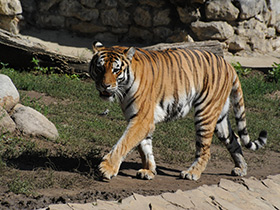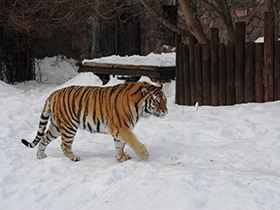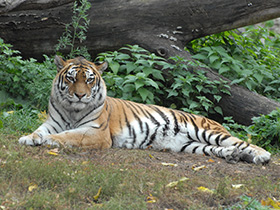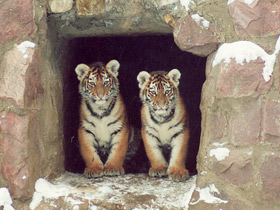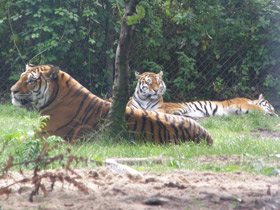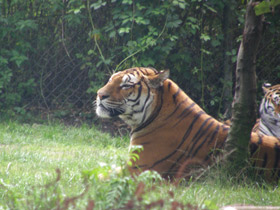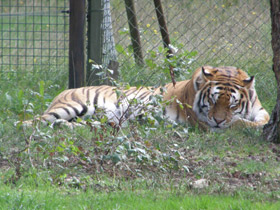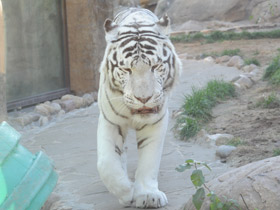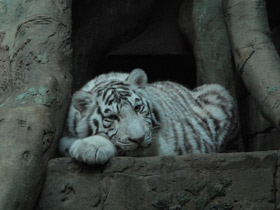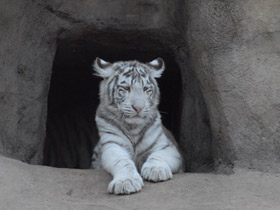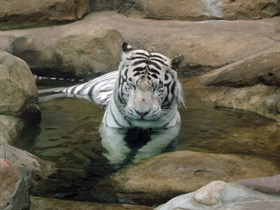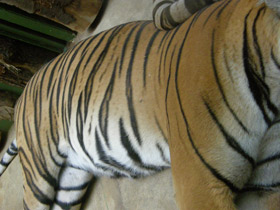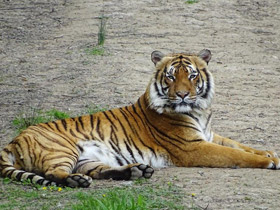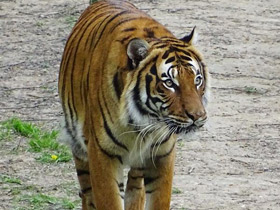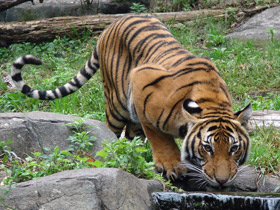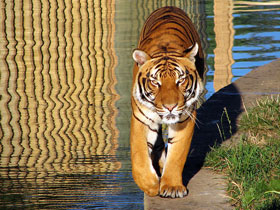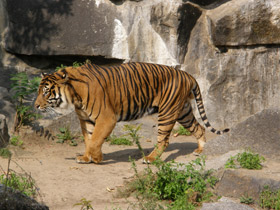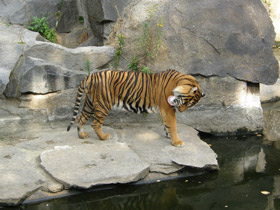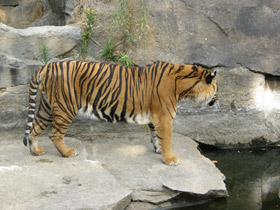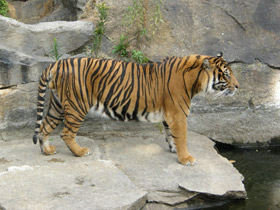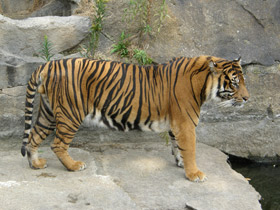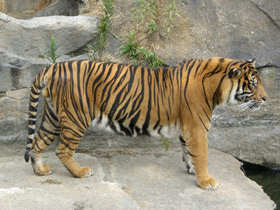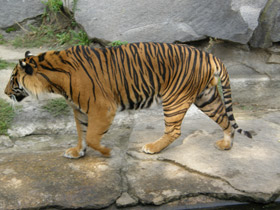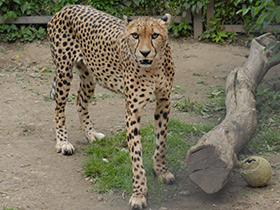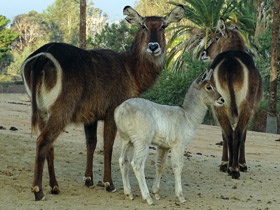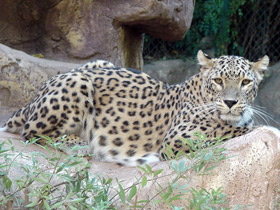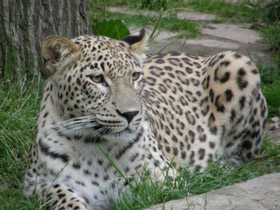The tiger (Panthera tigris)
 The tiger(Panthera tigris) is included in the IUCN Red List as an "endangered species"
The tiger(Panthera tigris) is included in the IUCN Red List as an "endangered species"
The tiger (Panthera tigris) is one of the species of the panther subfamily (family Felidae) belonging to the genus Panthera. Found only on the Asian continent, it is a carnivorous predator and is the largest felid species in the world along with the lion, both of which can reach a size comparable to that of the largest felid fossils.
There are six subspecies of tigers, of which the Bengal tiger is the most numerous; it makes up about 80% of the total population of the species; it is found in India, Bangladesh, Bhutan, Burma and Nepal. It is an endangered species, and most of the world's tigers now live in captivity. The tiger is the national animal of Bangladesh and India.
Etymology
The Middle English tigre and Old English tigras derive from Old French tigre, from Latin tigris. This was a borrowing of Classical Greek τίγρις 'tigris', a foreign borrowing of unknown origin meaning 'tiger' and the river Tigris. The origin may have been the Persian word tigra ('pointed or sharp') and the Avestan word tigrhi ('arrow'), perhaps referring to the speed of the tiger's leap, although these words are not known to have any meanings associated with tigers.
The generic name Panthera is derived from the Latin word panthera and the Ancient Greek word πάνθηρ ('panther').
Taxonomy
In 1758, Carl Linnaeus described the tiger in his work Systema Naturae and gave it the scientific name Felis tigris. In 1929, the British taxonomist Reginald Innes Pocock subordinated the species under the genus Panthera using the scientific name Panthera tigris.
Subspecies
Nine subspecies of tiger inhabited Asia in recent times, of which three are extinct and another is in serious danger of becoming extinct in the not-too-distant future. Their historical distribution (now much reduced) was mainly in Russia, Iran, Afghanistan, India, China and Southeast Asia, including the Indonesian islands. The following are the surviving subspecies of the tiger, in order of wild population:
The Bengal tiger, also known as the royal tiger or Indian tiger (Panthera tigris tigris), is found in India, Bangladesh, Nepal, Bhutan and Burma. It can be found in a variety of places, from rainforests to savannahs. The Indian government estimates that the total population of the Bengal tiger may be around 2000 wild individuals, of which about 170,629 are found in India.3031 In 1972, India launched Project Tiger, with the aim of protecting the tiger population in India. The project worked for a time, increasing the Bengal tiger population from 1200 in the 1970s to over 3000 in the 1990s, and is considered one of the most successful wildlife conservation projects. However, even though this subspecies of tiger is the most numerous, it is still under severe threat of being wiped out, as habitat destruction and poaching (which has increased again due to the loss of effectiveness of the project) have caused the population of this tiger to decline considerably in recent years. The Indian tiger is one of the largest subspecies, weighing 175-260 kg for males and 100-160 kg for females.32 However, tigers inhabiting Nepal and northern India are generally larger than those inhabiting the central Indian subcontinent and the Sundarbans.
The Indochinese tiger, also called Corbett's tiger (Panthera tigris corbetti), is found in Cambodia, China, Laos, Burma, Thailand and Vietnam. Estimates of its total population in the wild are variable, so its exact numbers are uncertain, although it is currently thought to be between 700 and 1300 individuals. The largest population of Indochinese tigers is in Malaysia, where illegal hunting has been controlled; however, all populations are threatened by habitat fragmentation and inbreeding. Indochinese tigers are smaller and darker-coated than Indian tigers; males weigh 150-190 kilograms, while smaller females weigh 100-130 kilograms.
The Malayan tiger (Panthera tigris jacksoni), found exclusively in the eastern Malay Peninsula, was not considered a true subspecies until 2004. Recent surveys indicate that its wild population may number just over 500 tigers, making it the third largest tiger subspecies after the Bengal and Indochinese tigers. The Malayan tiger is a national animal in Malaysia. The average estimated weight for males is 120 kg, while the average weight for females is 100 kg.
The Sumatran tiger (Panthera tigris sumatrae) is found only on the Indonesian island of Sumatra. Its wild population is estimated to be between 400 and 500 individuals, and is found mainly in the island's national parks. Recent DNA analysis reveals the existence of certain unique gene characteristics, indicating that the Sumatran tiger is on the borderline between the subspecies and its separation as a new species distinct from the other tigers if it does not become extinct sooner.35 For this reason, it has been suggested that even more effort should be devoted to the conservation of the Sumatran tiger than the remaining subspecies. Habitat destruction (which continues even in supposedly protected national parks) is its main threat; in addition, between 1998 and 2000, 66 tigers were shot dead, constituting approximately 20% of its total population. Among the current subspecies of the tiger, the Sumatran tiger is the smallest, weighing 100-140 kg for males and 75-110 kg for females. Its small size is due to an adaptation to the dense forests of the island of Sumatra, where it lives. On 3 February 2007, a pregnant Sumatran tigress was captured by people in Rokan Hilir village in Riau province. Wildlife conservation officials are planning to transfer the tigress to the Bogor Zoo in Java.
The Amur tiger (Panthera tigris altaica), also called the Siberian, Manchurian, or northern Chinese tiger, is found in the Amur region of Far Eastern Siberia, where it is currently a protected species. The latest census (conducted in 2014) by the World Wildlife Fund (WWF) revealed that the wild population of the Amur tiger numbers around 400,36 a population that remains more or less stable today. Considered the largest felid in the world (with the exception of the liger, a hybrid between a lion and a tigress), the largest specimen hunted in the wild was a male weighing 384 kg and a captive specimen reached 465 kg; however, the average weight for males is 225 kg, and for females 127 kg.37 A specimen of only six months of age can be as large as an adult leopard. It is characterised by a thick layer of fat (especially in winter), a paler fawn coat than the other subspecies, and fewer stripes.
The southern Chinese tiger (Panthera tigris amoyensis), also known as the Amoy, or Xiamen, tiger, is the most endangered of all tiger subspecies, and faces near extinction. It is one of the smallest subspecies of Panthera tigris, with males weighing 130-175 kg and the considerably smaller females typically weighing 100-115 kg. The last wild southern Chinese tiger was hunted in 1994, and since then, no further sightings of wild tigers have been confirmed. In 1977, the Chinese government passed a law banning the hunting of tigers in the wild, but it seems to have been too late to save the subspecies. There are now only 59 tigers left, descended from 6 captured animals, all of which now live in Chinese zoos. Efforts are now being made to reintroduce these tigers by 2008.
The Siberian tiger (Panthera tigris altaica)
 The Siberian tiger (Panthera tigris altaica) is included in the Russian Red List
The Siberian tiger (Panthera tigris altaica) is included in the Russian Red List
The Siberian tiger (Panthera tigris altaica), also known as the Amur tiger, Caspian tiger or Persian tiger (Panthera tigris virgata), is a subspecies of tiger that currently occupies only the evergreen and mixed forests of the south-eastern corner of Russia, in the Amur River region and the Russian-Chinese border.
Appearance
Panthera tigris altaica is the largest and northernmost of all tiger subspecies (photo 1, 2). Winters in the northern taiga are very harsh, so the fur of Amur tigers is much thicker and longer than that of their southern siblings, and their colour is lighter, matching the colour of the snow (photo 3, 4).
Only the Amur tiger has a five-centimetre layer of fat on its belly to protect it from the cold and icy wind. Its ears are much shorter than those of other subspecies to avoid frostbite. This powerful and beautiful predator has an elongated and flexible body, a large rounded head, strong legs and a long tail (photo 5).
The largest member of the cat family, Panthera tigris altaica, is even larger than the king of beasts, the lion: males can reach 380 cm in length and 110 cm at the withers, weighing between 160 and 270 kg (females are clearly smaller).
Nutrition and behaviour.
Tigers lead a solitary life, each tiger having a large hunting ground covering an area of up to 500 km² or more. If there is enough food in this area, the host can stay there for a long time. It marks its territory with urine and scratches on the bark of trees, and constantly monitors its own and others' markings. The tiger is an excellent hunter; its enormous physical strength and size allow it to hunt large game, but it sometimes does not disdain fish, frogs, birds and mice; sometimes it also eats the fruits of some plants. However, the Amur tiger's diet consists mainly of ungulates: Manchurian deer, spotted and red deer, roe deer, wild pigs and elk. Despite its natural predatory qualities, the tiger is far from always successful in a tiger fight: for every 6 or 7 attacks, it has only one successful one.
Reproduction
As Panthera tigris altaica has a very large territory, the female usually goes in search of a mate. The gestation period is 95-112 days, after which 3 to 4 blind tiger cubs are born.
Their eyes open at 9 days and their teeth begin to grow at two weeks of age. The two-month-old cubs already occasionally come out of their shelter and play in the open air. Their mother brings them meat, although she continues to feed them milk for another 5 to 6 months. At six months of age, the cubs begin to accompany their mother on hunts, but it takes them a long time to learn all the tricks of the hunt. Tiger cubs play a lot, which also helps them learn the skills necessary for hunting. At one year of age, they hunt for the first time and by the age of two they can catch larger prey. However, for the first few years of their lives, young tigers remain close to their mother and hunt alongside her.
Conservation status
A regular census of Panthera tigris altaica shows that there are very few left, no more than 400 individuals. This rare animal is included in the IUCN Red List. The main reason for the tiger's decline is the destruction of its habitat and the animals it hunts. Poaching is a serious problem.
Bengal tiger (Panthera tigris tigris or Panthera tigris bengalensis) , also known as Royal Bengal tiger or Indian tiger
Habitat area
The Bengal tiger (Panthera tigris tigris or Panthera tigris bengalensis), also known as the Royal Bengal tiger or Indian tiger, is a subspecies of tiger inhabiting northern and central India, eastern Iran, Nepal, Myanmar and Bangladesh, Bhutan, Burma and Tibet.
It is the most numerous and best known subspecies of tiger, and is found in a wide variety of habitats, including savannahs and tropical and subtropical forests. The Bengal tiger inhabits a wide range of habitats, from tropical rainforests to dry savannahs and mangroves.
The tiger is a national animal in India and Bangladesh.
Appearance
This subspecies is smaller than Panthera tigris altaica: males reach 205-227 kg, while females typically weigh 140-150 kg. The body length of males varies from 270 to 310 cm (some animals are reported to reach 370 cm), females are smaller - 240 to 265 cm (maximum up to 290 cm), tail length is 85 to 110 cm, height at withers is 90 to 110 cm. The colour of Panthera tigris tigris varies from yellow to light orange and the stripes are dark brown to black, its belly is white and its tail is predominantly white with black rings. The roar of Panthera tigris tigris can be heard up to 3 km away.
Nutrition
The main prey of Panthera tigris tigris are various ungulates: wild boar, roe deer, spotted deer, barassins, Indian zambar, antelope and even large and dangerous animals such as buffalo and gaur. However, Panthera tigris tigris can also hunt predators such as foxes, red wolves and jackals; it is unfazed by monkeys, porcupines, birds, snakes and frogs, fish, insects and carrion. Panthera tigris tigris can eat up to 40 kg of meat in a single meal and can survive a three-week hunger strike.
Conservation status
Panthera tigris tigris is more abundant than all other subspecies. According to the Indian government, about 2,000 tigers live in India. About 200 tigers live in Bangladesh, 140 in Pakistan, 155 in Nepal, about 30 in Iran and about 70 in Bhutan; in Afghanistan the tiger has been completely subdued. But despite this, the Panthera tigris tigris is also endangered, mainly due to poaching and the destruction of its natural habitat. Poachers kill about 150 tigers every year for their skin, bones and internal organs, which are widely used in traditional medicine in China and other countries.
Panthera tigris tigris is the national animal of Bangladesh and India.
The white tiger Panthera tigris (var. Alba)
Appearance
White tiger (Panthera tigris (var. Alba)) - is not a distinct species of tiger, nor is it an albino tiger. It is a colour variation found in Panthera tigris tigris, in which a rare mutation occurs resulting in individuals with brown stripes on a white background and blue eyes. The frequency of occurrence of white tigers is 1 individual per 10,000 with normal colouration.
In the wild, they are rarely seen, as the white colour makes the animal too conspicuous and makes it impossible to sneak up on prey or hide from enemies. In captivity, however, white tigers live and breed successfully, and their way of life does not differ from that of their red brothers.
Particularities
The first records of polar tigers date back to 1951, when during a big hunt in India hunters chased a female tiger with four nine-month-old cubs. Three of them were of normal colour, and the fourth was white; it was bigger and stronger than all the others. The white calf was taken to the raja, who liked it very much. When the cub grew up, the raja offered him a red tiger cub as a mate; they had three cubs, but they were all common. The female of the second litter was then mated with her father. The resulting offspring consisted of four white cubs identical to their father: brown stripes on a white background, pink paw pads and pale blue eyes. Today, more than a hundred white tigers live in zoos around the world, and all of them are descendants of these tiger cubs.
In India, the white tiger is treated with great reverence and it is believed that the man who encounters a white tiger will be endowed with happiness and wealth.
Photos
- Photos 5 and 11 - The tiger's tongue is rough as a grater; it helps it not only to care for its fur but also to scrape the flesh from its bones.
- Photos 9 and 10 - the tiger with one of its toys at the Moscow Zoo.
- Photo 12 - the tiger resting.
- Photos 13-21 - tiger cubs.
Corbett's tiger or Indochinese tiger (Panthera tigris corbetti)
Video of the tiger
двухмесячный тигренок играет с 8-месячным сородичем. Источник: канал Youtube Carlos lumicuchiA two-month-old tiger cub plays with its 8-month-old cousin.
Source: Carlos lumicuchi's Youtube channel.
Habitat area
The Corbett's tiger or Indochinese tiger (Panthera tigris corbetti) is a subspecies of tiger found in Cambodia, southeastern border of China, Laos, northern Malacca, Burma, Thailand and Vietnam. These predators live in subtropical rainforests and dry tropical forests, as well as in mountainous areas along the banks of the Mekong and Salween rivers.
Appearance and nutrition
This subspecies of tiger is named after the English naturalist Jim Corbett. Male Panthera tigris corbetti range in length from 2.55 to 2.85 m and weigh between 150 and 195 kg (although some larger specimens weigh more than 250 kg); females weigh no more than 130 kg. Panthera tigris corbetti feeds mainly on wild ungulates such as pigs, large caribou and bulls; it also eats smaller animals such as porcupines, monkeys, birds, fish and even reptiles, and does not shy away from carrion.
Conservation status
There are only about 1,500 Panthera tigris corbetti in the wild, with another 60 kept in zoos. This rare cat is listed in the International Red Data Book as endangered, but unfortunately, despite this, Indochinese tigers continue to be destroyed by poachers. In Vietnam, almost three-quarters of Panthera tigris corbetti have been destroyed to sell their organs, which are used to make Chinese medicines.
Malayan tiger (Panthera tigris jacksoni)
Video of the tiger
Tiger видео
Appearance and distribution
The Malayan tiger (Panthera tigris jacksoni) is a subspecies of tiger found only in some areas of the Malay Peninsula in Malaysia and Thailand. Until 2004, these populations were considered to belong to the Indochinese subspecies Panthera tigris corbetti, but a study by scientists at the US National Cancer Institute, led by researcher Stephen J. O'Brien, showed that despite the strong anatomical resemblance between the two animals, Panthera tigris jacksoni were sufficiently genetically distinct to be considered a subspecies in their own right.
The decisive factor was the genetic differences found between the two subspecies. Recent studies have shown between 500 and 600 individuals of this subspecies of tiger in the wild, making it the third most abundant of the other subspecies.
Panthera tigris jacksoni is the smallest of the tiger subspecies. Its colouring and stripes are similar to those of the Indochinese tiger, but its size is more similar to that of the Sumatran tiger: males weigh about 120 kg and females about 100 kg; male body length is up to 237 cm and female body length up to 200 cm.
Nutrition and social behaviour
Panthera tigris jacksoni prey on zebra deer, barking deer, wild boar and other ungulates, and even prey on Malayan bears, baby elephants and rhinos. The diet of this subspecies of tiger may include tapir, but this prey is probably very rare. Males usually occupy an area of up to 100 km², where up to 6 females often coexist simultaneously.
Sumatran tiger (Panthera tigris sumatrae)
Video of the tiger
Tiger видео
Habitat area
The Sumatran tiger (Panthera tigris sumatrae) is a subspecies of tiger found only on the Indonesian island of Sumatra.
Most of the subspecies (about 400 individuals) is found in nature reserves and national parks. Recent genetic studies have shown the presence of unique genetic markers in the genotype of the subspecies; this is an indication that a separate cat species may develop from the subspecies over time (if the subspecies is not eradicated). Based on this, many scientists believe that Panthera tigris sumatrae is more worthy of conservation than any of the other subspecies.
The main threat to the Sumatran tiger is environmental destruction (deforestation occurs even in highly protected areas of Sumatra) and between 1998 and 2000, 66 tigers (or 20% of the population) were killed by poachers.
Appearance and behaviour
Panthera tigris sumatrae is about the same size as the Malayan tiger, with adult males weighing 100-130 kg and females 70-90 kg. The relatively small size of this subspecies is thought to be adapted to life in a densely populated rainforest. Despite its modest size, the subspecies is quite aggressive.
Panthera tigris sumatrae is very fond of water: it is an excellent swimmer and in hot weather can stay in the water for a long time. Unlike other subspecies, male Panthera tigris sumatrae are said to stay with their females until the young become adolescents.
Threats to existence
The wild population is estimated at 400-500 animals, most of which live in national parks and reserves. The main threat to these animals is environmental degradation (deforestation takes place even within the strictly protected areas of Sumatra); however, between 1998 and 2000, 66 tigers (20% of the population) were killed by poachers.
Amoy's tiger, South China tiger or Xiamen tiger (Panthera tigris amoyensis)
Habitat
The Amoy's tiger, South China tiger or Xiamen tiger (Panthera tigris amoyensis) is the most endangered of all tiger subspecies. It is also the smallest subspecies in existence. In the late 19th and 20th centuries, its range covered southern central China and is now limited to Fujian, Guangdong, Jiangxi and Hunan provinces. The Latin name was given to the subspecies after the island of Xiamen (Amoy), where the beast managed to migrate from mainland China.
The habitat of the Chinese tiger is deciduous forest with dense undergrowth and a mixture of conifers, at altitudes of 1000-3000 m, seashores, mangroves and river valleys.
Appearance
Adult Panthera tigris amoyensis, unlike the Amur, is relatively small in size. Males weigh between 127 and 177 kilograms and females between 100 and 118 kilograms. The distinguishing feature of Chinese tigers is their tusks, which are up to 4 centimetres long. Their paws are very powerful, with a kick of up to 500 kilograms, enough to kill a buffalo with a single blow.
Nutrition and behaviour
Panthera tigris amoyensis form family pairs only during the breeding season, the rest of the time they live alone. These animals are good swimmers and can reach speeds of up to 56 km/h; they have excellent hearing and eyesight. Tigers make their dens in dense thickets, in rock crevices and under fallen tree trunks. They usually follow the same routes, marking their territory with urine; they strip the bark from some trees along the way.
Chinese tigers hunt at any time of the day or night. They feed mainly on deer and wild pigs. Primates, porcupines, reptiles, birds and fish are not uncommon prey. Tigers attack larger prey from behind, snapping their necks with their paws or digging their fangs into their throats.
Reproduction
Female Panthera tigris amoyensis incubates her cubs for about three months. The cubs are born in winter. A litter consists of 2 to 4 blind cubs. They are fed on mother's milk until 4-5 months of age, and become accustomed to meat after two months. Young animals hunt actively from the age of one year, and at the age of two they are ready to lead an independent life.
Population numbers and threats
Not so long ago, the population of Panthera tigris amoyensis exceeded 4,000. The beast inhabited hard-to-reach areas of China, was good at hiding from humans, could attack livestock, and there were cases of cannibalism. Active hunting did not begin until the 1940s, was commercial in nature and quickly led to the almost total extermination of the population. Even a shot Panthera tigris amoyensis fetched fabulous money for poachers, who were willing to risk life and limb for it. The organs of Panthera tigris amoyensis were used to make oriental remedies and the skin was made into a carpet, an exotic handbag or a souvenir.
The Chinese authorities banned shooting the predator in 1977. The last case of poaching dates back to 1994.
Active exploitation of wildlife by humans, the displacement of Panthera tigris amoyensis to uninhabitable areas, the reduction of feeding grounds and the pollution of water sources by industrial and agricultural run-off have also contributed to a critical reduction in numbers of the subspecies.
There are currently no more than 20-25 individuals of Chinese tigers left in the wild, and there is only indirect evidence of their presence in certain areas. The data are based on eyewitness reports of Panthera tigris amoyensis in protected areas, isolated tracks found on mountain trails and tree markings. The animals have not yet been captured by CCTV cameras operating in China's five provinces.
Around 70 raptors are in captivity worldwide, most of them living in Chinese zoos. The animals in China are closely related, are the offspring of only six individuals and do not breed well.
In 2000, Save Chinas Tigers, a non-governmental charitable foundation, was established with the primary goal of restoring the numbers of these predators and returning them to the wild. Its offices are located in the United States, the United Kingdom and Hong Kong. The Chinese government is actively involved in the foundation's programme and has supported it since 2008.










